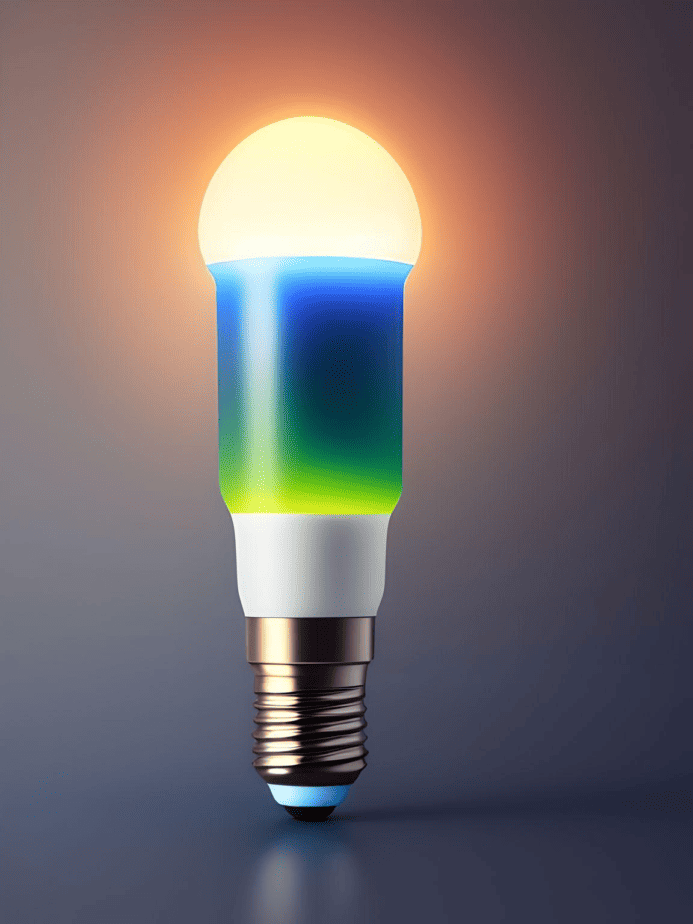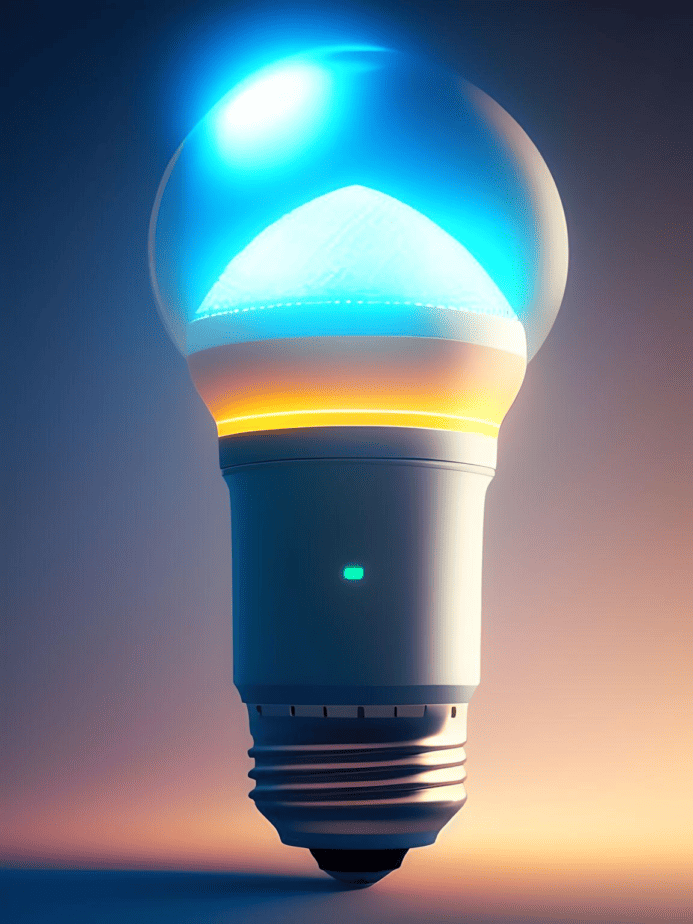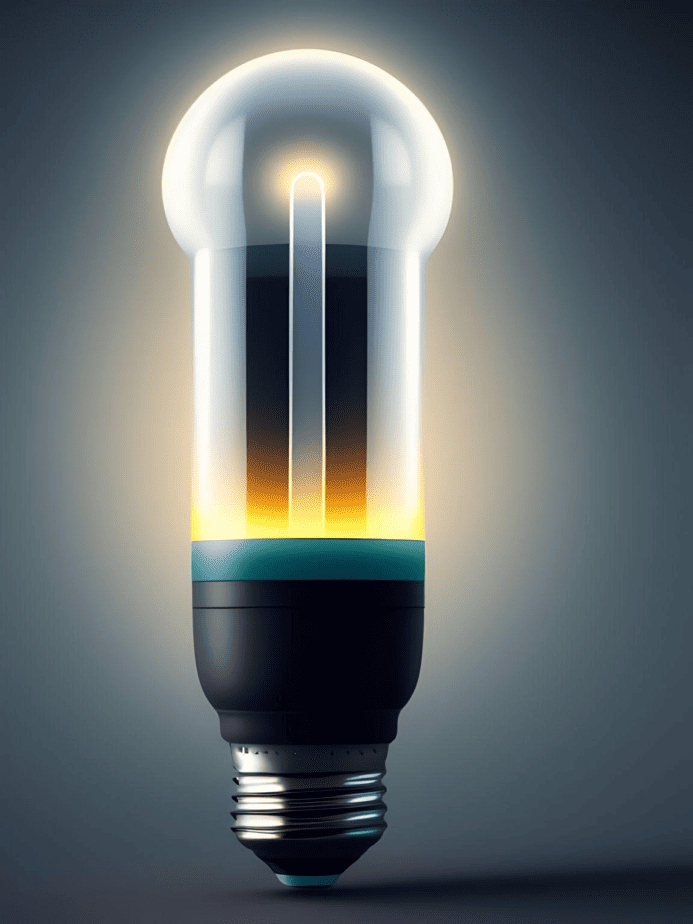In an era of remarkable technological advancements, it’s no surprise that smart bulbs have taken the world of lighting by storm. These intelligent illuminators have quickly gained popularity due to their ability to transform ordinary spaces into extraordinary ones. With their seamless integration of cutting-edge technology and traditional switches, smart bulbs have become a beacon of innovation in the realm of lighting control.
Smart bulbs work with switches by staying powered on while utilizing wireless connectivity. Use dedicated apps or smart home systems for control, enabling features like dimming, scheduling, color changes, and voice control. Tap or command to transform your lighting experience.
The impact of smart bulbs extends beyond mere convenience. They are also paving the way for a greener future, with their energy-efficient designs that can lead to substantial energy savings. By empowering users with control over brightness levels and color temperatures, smart bulbs provide the perfect lighting environment for any occasion, whether it’s a cozy movie night or an energizing workout session.
When Do the Street Lights Turn On?
Understanding Smart Bulbs: Shedding Light on the Future of Illumination
Smart bulbs have emerged as the shining stars of the lighting industry, captivating both men and women with their remarkable features and capabilities. But what exactly are these luminous wonders, and how do they set themselves apart from their traditional counterparts?

Enlightening the Path: Defining Smart Bulbs
Smart bulbs, also known as intelligent bulbs or connected bulbs, are lighting devices that have been imbued with cutting-edge technology to provide an unparalleled lighting experience. Unlike traditional bulbs, which simply emit light when powered on, smart bulbs possess advanced functionalities that go beyond mere illumination.
A Symphony of Innovation: How Smart Bulbs Differ
The key differentiating factor lies in the remarkable control and connectivity options that smart bulbs offer. While traditional bulbs rely solely on physical switches for operation, smart bulbs harness the power of wireless connectivity and intelligent software to revolutionize the way we interact with lighting.

Remote Control at Your Fingertips:
One of the most alluring aspects of smart bulbs is their ability to be controlled remotely. Through dedicated mobile applications or compatible smart home platforms, you can effortlessly adjust brightness levels, customize color temperatures, and even schedule lighting scenes to suit your preferences, all with a few taps on your smartphone or tablet.
The Magic of Automation:
Smart bulbs also introduce the captivating concept of automation. With the help of built-in sensors or integration with external devices like motion detectors, they can adapt their behavior based on your presence or ambient conditions. Imagine entering a room, and the lights gracefully illuminate, perfectly setting the mood for your arrival.
Let There Be Voice Control:
Embracing the era of virtual assistants and voice command technology, smart bulbs seamlessly integrate with popular platforms like Amazon Alexa or Google Assistant. By simply uttering a voice command, you can effortlessly illuminate or dim your lights, freeing your hands and providing a whole new level of convenience.
The Illuminated Future Awaits:
Now that we’ve shed light on the fundamental distinctions between smart bulbs and traditional bulbs, it’s clear that these intelligent luminaires are poised to shape the future of illumination. The blend of wireless connectivity, intuitive control, and automation capabilities opens up a world of possibilities, transforming your living spaces into personalized havens of light.
Which Is Brighter: HID or LED?
Working Principles of Smart Bulbs: Illuminating the Magic Behind the Glow
To truly understand the enchanting capabilities of smart bulbs and how they seamlessly work with switches, we must delve into the intricate working principles that bring them to life. Let’s embark on an illuminating journey to explore the underlying technology and components that make these intelligent luminaires shine.
Shedding Light on the Technology
Smart bulbs leverage a blend of cutting-edge technologies to offer a transformative lighting experience. At the heart of their functionality lies the integration of wireless connectivity, intelligent software, and innovative hardware components.
Embracing Wireless Connectivity
Wireless connectivity, such as Wi-Fi or Bluetooth, plays a pivotal role in enabling communication between smart bulbs and external devices like switches, smartphones, or voice assistants. This wireless connection establishes a seamless bridge, empowering you to control your lights from anywhere within the range of your network.
Intelligent Software: The Magic Behind the Scenes
Embedded within the smart bulbs is intelligent software that acts as the brain, enabling a wide array of functionalities. This software facilitates the communication and synchronization between the bulbs and the controlling devices, be it a dedicated mobile app or a voice assistant. It allows for precise control over color, brightness, scheduling, and even automation, granting you the power to create captivating lighting scenes at your fingertips.
Hardware Components: Engineering Brilliance
Behind the sleek exteriors of smart bulbs, a multitude of sophisticated hardware components work harmoniously to deliver a superior lighting experience. These components may include LED light sources, microcontrollers, memory chips, sensors, and wireless modules. Each element plays a vital role in the overall performance and functionality of the smart bulb, ensuring a flawless and immersive lighting experience.
Integration with Switches: Where Tradition Meets Innovation
Smart bulbs offer a bridge between the past and the future, seamlessly integrating with traditional switches to provide a harmonious lighting control experience. Let’s explore how these innovative luminaires can coexist with conventional switches, bringing a touch of modernity to your everyday life.

The Coexistence of Old and New:
One of the remarkable features of smart bulbs is their ability to work in conjunction with traditional switches. This means you can continue using your existing switches to turn the lights on or off, just as you would with regular bulbs. The familiar tactile experience of flipping a switch remains intact, providing a sense of comfort and familiarity.
Smart Control Unleashed:
While traditional switches offer basic control, the real magic happens when you combine them with the smart capabilities of your bulbs. By connecting your smart bulbs to a compatible app or a smart home hub, you gain access to a world of advanced functionalities. From adjusting brightness and color to creating customized lighting scenes, the power to transform your environment is at your fingertips.
Flexibility at Your Command:
The integration of smart bulbs with switches gives you the flexibility to choose the control method that suits your needs. Whether it’s using the physical switch for quick, hands-on control or utilizing the convenience of app-based or voice-activated control, the choice is yours. You have the freedom to switch between different modes of control effortlessly.
Stay tuned as we continue our exploration, comparing the advantages and limitations of traditional switch control and smart control in the next section. Discover the best of both worlds as we shed light on the endless possibilities that smart bulbs offer when integrated with switches.

The Ultimate Guide to Under Cabinet Lighting
Two Modes of Operation: Unveiling the Power of Choice
When it comes to controlling your lighting, you have two distinct modes at your disposal: traditional switch control and smart control. Let’s compare these modes and shed light on their unique advantages and limitations, allowing you to make an informed choice that suits your lifestyle.
Traditional Switch Control: Embracing Simplicity
Advantages:
- Familiarity: Traditional switch control offers a sense of familiarity, as it follows the long-established method of manually flipping a switch to turn your lights on or off.
- Instant Access: With a physical switch at your fingertips, you have instant control over your lighting, without the need for additional devices or connectivity.
Limitations:
- Limited Functionality: Traditional switches provide basic on/off control, lacking the ability to adjust brightness, change colors, or create dynamic lighting scenes.
- Lack of Automation: Without smart capabilities, traditional switches cannot automate your lighting based on specific conditions or schedules.
Smart Control: Empowering Possibilities
Advantages:
- Customization: Smart control allows you to customize your lighting experience with precision. Adjust brightness, change colors, and create personalized lighting scenes tailored to your mood or activity.
- Convenience: With smart control, you can effortlessly control your lights through dedicated mobile apps, voice assistants, or smart home platforms, offering a seamless and intuitive experience.
- Automation and Integration: Smart control enables automation by integrating with sensors, timers, or even other smart devices. You can create lighting routines that adapt to your presence or sync with other automated actions in your home.
Limitations:
- Initial Setup: Setting up smart control requires a bit of initial configuration, including connecting your smart bulbs to your Wi-Fi network and installing the necessary apps or hub devices.
- Dependency on Connectivity: Smart control relies on wireless connectivity. In case of network or internet outages, controlling your lights may be temporarily disrupted.
Bookshelf Lighting: Illuminating Your Literary Haven with Style and Functionality
Compatibility with Existing Wiring: Effortless Integration
One of the remarkable aspects of smart bulbs is their seamless compatibility with existing wiring in standard electrical installations. This compatibility eliminates the need for extensive modifications, allowing you to easily upgrade to smart lighting without hassle.

Plug and Play
Smart bulbs are designed to fit into standard light fixtures and sockets, making the installation process as simple as replacing traditional bulbs. Once installed, you can control them using both traditional switches and smart control methods, giving you the flexibility to choose the mode that suits your preference.
The Power of Retrofitting
Thanks to their compact size and compatibility, smart bulbs offer a convenient retrofitting solution. Whether you have recessed lights, pendant fixtures, or table lamps, smart bulbs can effortlessly replace their traditional counterparts, instantly transforming your space into an intelligent lighting ecosystem.
Stay tuned as we delve into the differences between smart switches and standard switches, uncovering the unique functionalities and features they bring to the table. Prepare to be enlightened as we explore the world of smart bulbs and their compatibility with various switch types, unraveling the secrets behind seamless lighting control.
Illuminate Your Pantry with the Perfect Pantry Light
Smart Switches vs. Standard Switches: Unveiling the Evolution of Control
In the world of lighting control, two contenders vie for supremacy: smart switches and standard switches. Let’s embark on an illuminating exploration to uncover the differences between these two switch types, unveiling their unique functionalities and features.
The Rise of Smart Switches
Smart Switches have emerged as the next evolution in lighting control, offering a plethora of advanced capabilities beyond the traditional on/off functionality. These intelligent switches are designed to seamlessly integrate with smart bulbs and provide enhanced control options, transforming your lighting experience.
Embracing Intelligence
Smart switches are equipped with built-in intelligence, allowing for enhanced functionality and customization. They offer features such as dimming control, color temperature adjustment, and even scene presets, enabling you to create the perfect ambiance with a simple touch.
Connectivity and Automation
Unlike their traditional counterparts, smart switches are typically connected to your home’s network. This connectivity opens up a world of possibilities, allowing you to control your lights remotely through mobile apps, voice commands, or smart home systems. Additionally, smart switches can be integrated with other smart devices and sensors, enabling automation and creating a truly smart ecosystem.
The Familiarity of Standard Switches
Standard switches, on the other hand, have long been a staple in lighting control. They offer simplicity and reliability, standing the test of time as a familiar and convenient way to operate your lights.
Basic On/Off Control
Standard switches provide straightforward on/off control for your lighting. With a simple flick of the switch, you can illuminate or darken a room, offering a tactile and immediate response.
Independence from Connectivity
Unlike smart switches, standard switches operate independently of network connectivity or external devices. They rely solely on the electrical wiring of your home, ensuring reliable control even in the absence of an internet connection or smart home infrastructure.
Mirror with Lights: Illuminate Your Reflection with Style
Benefits of Smart Bulbs with Switches: Illuminating Advantages
Integrating smart bulbs with switches brings forth a myriad of advantages that enhance your lighting experience. Let’s delve into the benefits of this intelligent pairing, uncovering the remarkable advantages they offer.
1. Energy Savings
By combining smart bulbs with switches, you gain the ability to easily control the lighting in your home, reducing energy consumption. With features like dimming and scheduling, you can optimize brightness levels and create lighting routines that align with your daily activities, resulting in significant energy savings over time.
2. Customization and Ambiance
Smart bulbs offer unparalleled customization options, allowing you to set the perfect ambiance for any occasion. With adjustable brightness, color temperature, and even color-changing capabilities, you can create personalized lighting scenes that suit your mood or complement the atmosphere of your space. By integrating with switches, you retain the flexibility to adjust your lighting settings using both traditional and smart control methods.
3. Convenience and Control
The integration of smart bulbs with switches brings convenience to your fingertips. With the ability to control your lights through physical switches, dedicated mobile apps, voice commands, or smart home platforms, you have the freedom to choose the control method that suits your preference. Whether you prefer the tactile response of a switch or the convenience of remote control, this pairing offers you the best of both worlds.
4. Automation and Smart Home Integration
Smart bulbs, when combined with switches, unlock a realm of automation possibilities. By integrating with sensors, timers, or other smart devices, you can create intelligent lighting routines that adapt to your lifestyle. Imagine your lights automatically turning on when you enter a room or syncing with your morning routine to gently wake you up with simulated sunlight. The synergy between smart bulbs and switches enables seamless integration within your smart home ecosystem.

Which Light is Best for Bedroom: Illuminating Your Haven of Rest
Installation and Setup Process: Enlightening Your Path
Installing and setting up smart bulbs to work harmoniously with switches may seem daunting at first, but fear not. Follow this step-by-step guide to embark on a hassle-free journey towards a seamlessly integrated lighting system.
- Gather your materials: Ensure you have the necessary smart bulbs, compatible switches, and any additional devices such as a smart hub or bridge, if required.
- Prepare the workspace: Turn off the power to the existing light fixtures at the circuit breaker to ensure safety during the installation process.
- Remove the old bulbs: Carefully unscrew and remove the traditional bulbs from their sockets, setting them aside for future use or disposal.
- Install the smart bulbs: Insert the smart bulbs into the empty sockets, ensuring a secure fit. Follow the manufacturer’s instructions for any additional setup steps, such as connecting the bulbs to your home’s Wi-Fi network.
- Replace or modify the switches: Depending on your preference and compatibility, you can either replace your existing switches with smart switches or use smart bulbs with your standard switches.
- Connect the switches: If you choose to install smart switches, follow the manufacturer’s instructions to connect them to your home’s electrical wiring and set them up with the corresponding mobile apps or hub devices.
- Test and configure: Once the installation is complete, restore power at the circuit breaker and test the functionality of your smart bulbs and switches. Use the respective apps or controls to configure settings, such as brightness levels, color options, or automation routines, to your liking.
- Enjoy your smart lighting: With your smart bulbs seamlessly integrated with switches, revel in the convenience and versatility they offer. Take full advantage of the customization options and explore the various ways you can enhance your lighting experience.
Troubleshooting and Tips: Illuminating Solutions
During the setup process, you may encounter common issues that can be easily resolved. Here are some troubleshooting tips to overcome potential hurdles:
- Connectivity issues: If your smart bulbs or switches are having trouble connecting to your home’s network, ensure that you have a stable Wi-Fi signal and check if your router’s settings are compatible with the devices. Restarting the router or repositioning it may help improve connectivity.
- Compatibility concerns: Before purchasing smart bulbs and switches, verify their compatibility with each other and any other devices or systems you plan to integrate. Consult the manufacturer’s documentation or online resources for comprehensive compatibility information.
- Firmware updates: Check for firmware updates for your smart bulbs, switches, or any associated hub devices. Keeping the firmware up to date ensures you have the latest features, improvements, and bug fixes.
- Resetting devices: If you encounter persistent issues, try resetting your smart bulbs or switches according to the manufacturer’s instructions. This action will restore them to their default settings and may resolve certain issues.
Remember, each manufacturer may have specific troubleshooting steps for their products. Consult their documentation or contact their customer support for tailored assistance.
Conclusion: Lighting the Way Forward
In conclusion, the integration of smart bulbs with switches opens up a world of possibilities for lighting control. By leveraging the advantages of energy savings, customization, convenience, and automation, you can transform your home into a haven of personalized illumination.
As technology continues to advance, the future of lighting control with smart bulbs and switches appears brighter than ever. Imagine a world where lighting seamlessly adapts to your needs, enhances your well-being, and fosters a harmonious environment. With this intelligent pairing, the future of lighting is within reach.
Embrace the power of smart bulbs with switches, and embark on a journey of illuminating possibilities that will revolutionize the way you perceive and interact with light. Illuminate your space, transform your ambiance, and embrace the future of lighting control.
